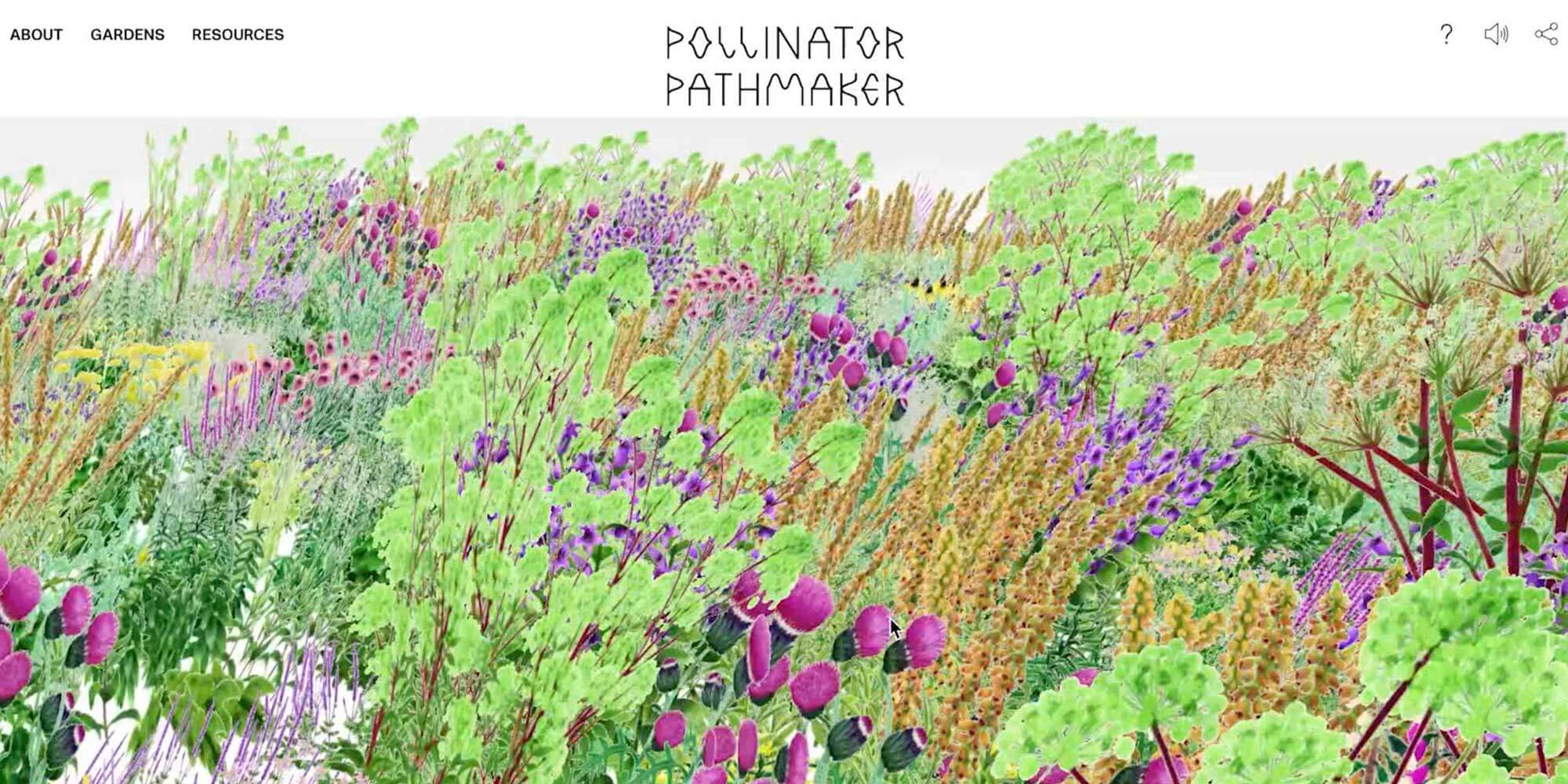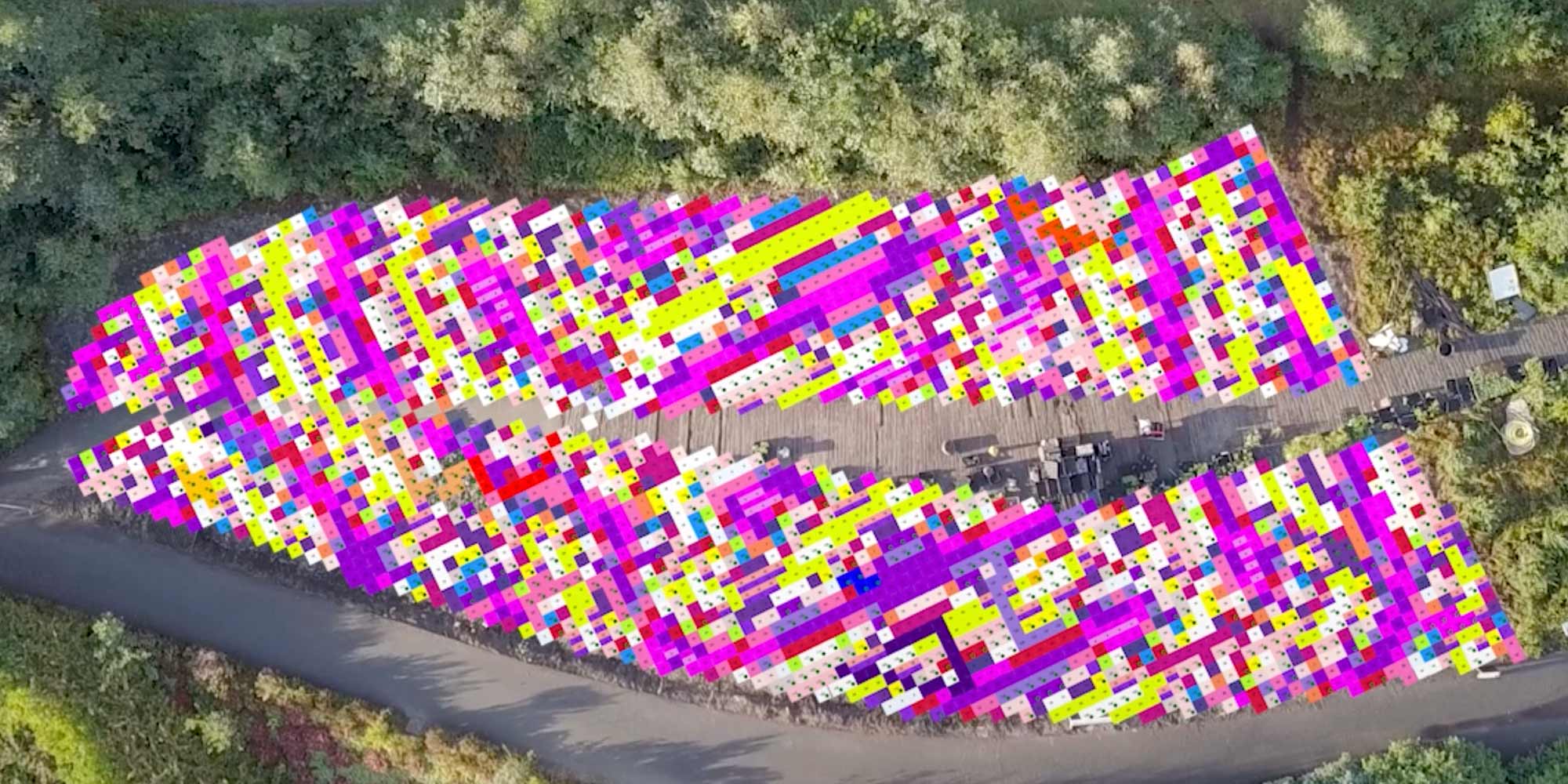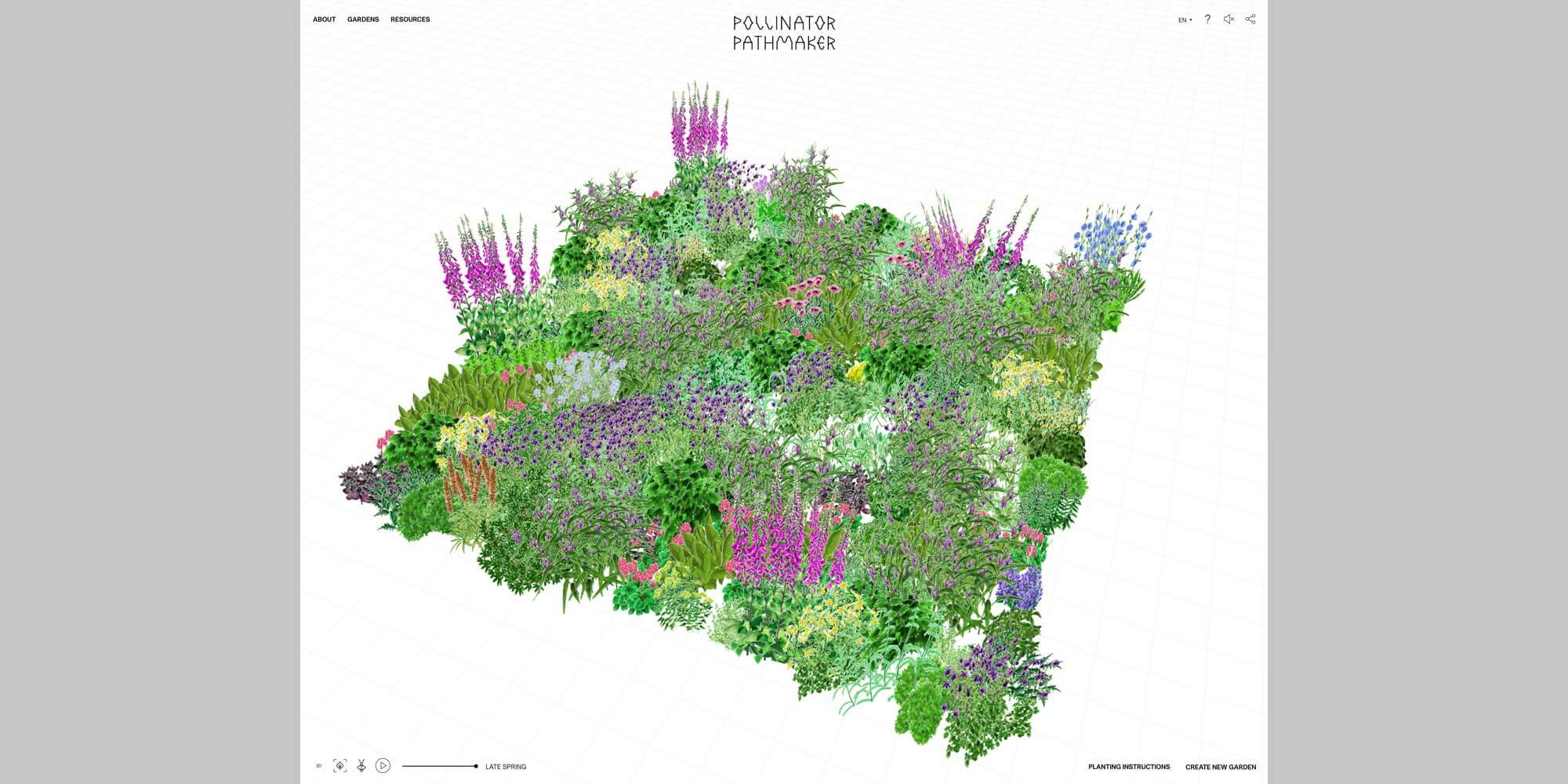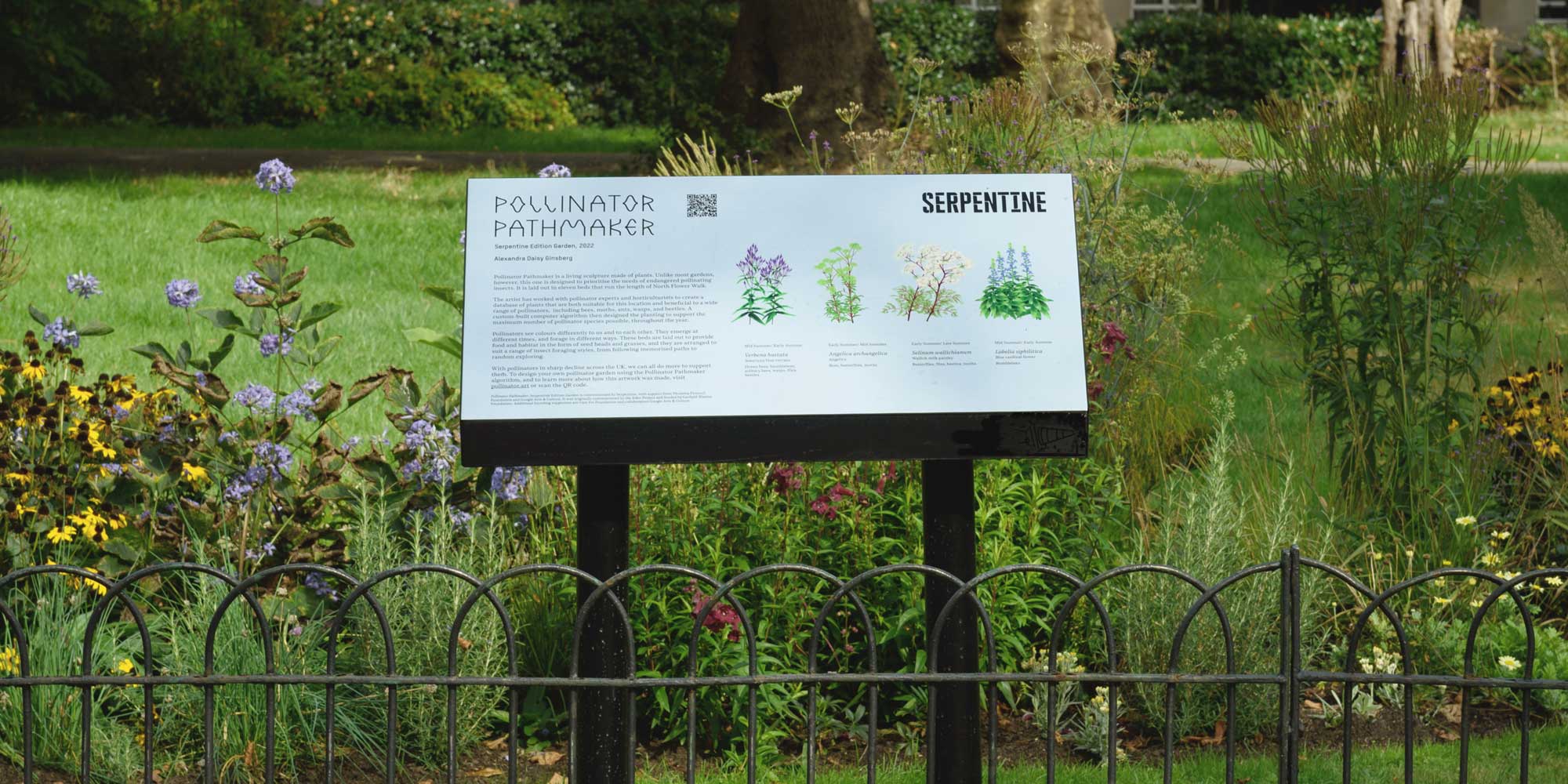Grand Prize – Artistic Exploration
Pollinator Pathmaker is an artwork for pollinators, planted and cared for by humans. Created by Alexandra Daisy Ginsberg in response to human-made ecological damage, the work is a one-of-a-kind experiment in interspecies art.

Bees, butterflies, moths, wasps, beetles, and other pollinators are essential for many plants to reproduce and our ecosystems to flourish. But human-made habitat loss, pesticides, invasive species, and climate change are triggering a terrifying decline in their populations. In response, Ginsberg devised an algorithmic tool that designs planting for pollinators’ tastes, not human taste. Working with horticulturalists, leading pollinator experts, and an AI scientist, Ginsberg created this tool to design with empathy for other species. The result is an unlimited edition of algorithmically-generated living artworks.
If pollinators designed gardens, what would humans see?
Insect pollinators experience the world differently from humans. They see colors differently from us, forage in different ways, and emerge in different seasons to each other. As a result, a garden designed for them may look quite different from a garden created for us.

Many plants need pollinators to help them reproduce, so they have evolved colors, patterns, shapes, scents, and delicious nectar to lure go-betweens to their pollen and transport it to other flowers of the same type. Co-evolution means that pollinators have evolved to suit the anatomy and seasons of specific flowers, and flowers have evolved to suit features of specific pollinators.

Pollinator species also have different foraging styles. Beetles explore patches more randomly, while bees and some other insects remember the locations of the flowers they visit, zapping along the most efficient flight paths, or ‘traplines.’ Since a bee may visit 10,000 flowers in a day, finding the fastest route between them is essential.
The loss of a single species of pollinator can mean the end of a plant species. Given all the many ways that plants and their pollinators co-exist, creating planting that maximizes pollinator diversity is not only vital, it’s also a complex challenge.
To encode a human emotion like empathy into an algorithm, Ginsberg defined empathy as designing planting that supports as many pollinator species as possible. The Pollinator Pathmaker algorithm selects and arranges plants to suit the different preferences of their different visitors. Since the algorithm is made by humans, it can’t completely remove human biases such as taste. But an algorithm can help to dull the effect of these choices and design for other species, rather than us.
The algorithm chooses plants from regional ‘Plant Palettes,’ developed by the artist with horticulturalists, pollinator experts, and by using published research and guides to pollinator-friendly plants.
Pollinator Pathmaker is based on a model of generosity: each commission of an international Edition includes curating a new regional Plant Palette that is added to use on pollinator.art. The public can use the platform to generate their own DIY Editions of Pollinator Pathmaker for free; by inputting where their garden is, how big it is, and its soil and light conditions, they can play with the algorithm’s empathy tools and create a unique planting design of their own. Gardens are not isolated spaces and here are reframed as interconnected networks across living landscapes.

Ginsberg’s aim is to create the world’s largest climate-positive artwork; this ambition relies on collaboration. Transforming us from consumers to caretakers of art, together, we can use art to create agency in this time of ecological crisis.

The first two Pollinator Pathmaker Editions opened in 2022; a 55 m permanent installation at the Eden Project, Cornwall, and eleven meandering beds over 250 m in Kensington Gardens, London, commissioned by the Serpentine. The next has been planted with LAS Art Foundation, Berlin, Germany, opening in June 2023.
Credits
Artist: Alexandra Daisy Ginsberg
Algorithm Developer: Dr Przemek Witaszczyk
Visual identity: Studio Frith
Sound design: Nick Ryan
Designer and Researcher: Iman Datoo
Horticulture: Colin Skelly
Producers: Hannah Andrews, Ruby Dixon, Cecilie Gravesen
Studio managers: Freire Barnes, Emily Sofaly
Pollinator Pathmaker Eden Project Edition, 2021
Commissioned by the Eden Project and funded by Garfield Weston Foundation
Additional founding supporters: Gaia Art Foundation
Collaborators: Google Arts & Culture
Curators: Misha Curson, Céline Holman, and Hannah Hooks
With thanks to the whole Eden team and PR, Nicola Jeffs
Pollinator Pathmaker Serpentine Edition, 2022
Commissioned by Eden Project and Serpentine
With support from Nicoletta Fiorucci Foundation and Google Arts & Culture
Curators Rebecca Lewin, and Sarah Hamed.
With thanks to the whole Serpentine team and The Royal Parks
Pollinator Pathmaker LAS Edition, 2023
Commissioned by LAS Art Foundation
With thanks to Dr Bettina Kames, Kristina Leipold, Curators Sophie Korschildgen and Carly Whitefield, Alexis Convento, and the whole LAS team, Museum für Naturkunde Berlin, and Königliche Gartenakademie
Originally commissioned by the Eden Project and funded by Garfield Weston Foundation.
Additional founding supporters: Gaia Art Foundation
Collaborators: Google Arts & Culture.
The International Edition Founding Commissioners are LAS Art Foundation.
Biography
Alexandra Daisy Ginsberg (GB) is a multidisciplinary artist examining our fraught relationships with nature and technology. Her work investigates the human impulse to “better” the world, exploring artificial intelligence, synthetic biology, conservation, biodiversity, and evolution. Ginsberg won the London Design Medal for Emerging Talent (2012), the Dezeen Changemaker Award (2019), and Prix Ars Electronica Honorary Mention, Interactive Art for Machine Auguries (2020). She has exhibited internationally, including at MoMA New York, the Museum of Contemporary Art, Tokyo, the Centre Pompidou, the Royal Academy, and the Toledo Museum of Art. In 2022, Ginsberg launched her climate-positive artwork Pollinator Pathmaker, with commissions at the Eden Project (Cornwall) and Serpentine (London). In 2023, Ginsberg launches the first international Edition with LAS Art Foundation (Berlin).
Jury Statement
Pollinator Pathmaker, a living plant sculpture designed to serve the natural world and the cause of ecological preservation, sets a benchmark in the realm of environmental art and biodiversity preservation. In its essence it is a remarkable piece of environmental art and conservation that holds the well-being of endangered pollinating insects above human aesthetics. It represents an innovative paradigm where art exists for the sake of these living organisms. The Pollinator Pathmaker creates a network of Edition Gardens, each uniquely designed to suit the needs of local pollinating species. These gardens have been carefully brought to life using sophisticated algorithmic tools and expert insights. This project invites humans to shift their perspective and view the garden through the eyes of these at-risk pollinators. It’s an innovative marriage of artistic creativity with scientific understanding that promotes ecological awareness. Expanding its roots from the UK to Berlin, Pollinator Pathmaker underscores its commitment to international collaboration and regional environmental sustainability. At the heart of the project is a custom-built algorithmic tool that draws on a curated plant database. The tool, working with horticulturalists and pollinator experts, uses unique Plant Palettes to select locally appropriate plants beneficial to pollinators. These Palettes cater to the specific needs of the pollinators in each region, enhancing habitats for bees, moths, ants, wasps, and beetles, and providing spaces tailored to their distinct pollinating styles.
The outcomes of this groundbreaking blend of art, science, and technology offer sanctuaries for pollinators, nurturing biodiversity and bolstering our ecosystem’s resilience. Beyond the gardens themselves, Pollinator Pathmaker extends its reach online. This platform empowers anyone to harness the power of its algorithm and design their own pollinator-friendly garden, encouraging wider engagement in environmental conservation. As Pollinator Pathmaker continues to blossom, it serves as a vivid illustration of the crucial role of innovative exploration at the intersection of art, ecology, and technology can play in tackling key ecological challenges. We eagerly anticipate more ‘artworks for pollinators,’ enhancing habitats and inspiring global environmental consciousness.



